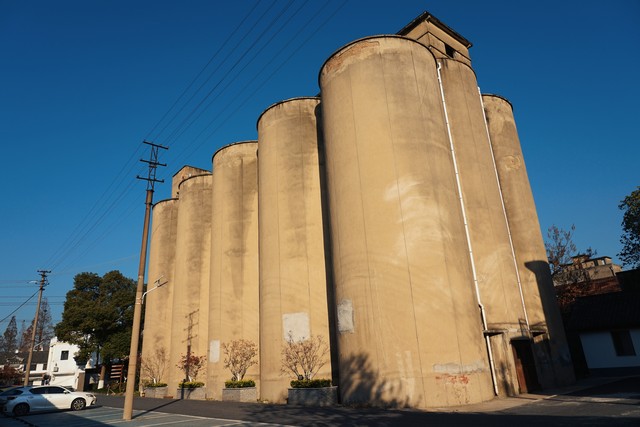
With a loud bang, a nearly 30 meter high giant grain silo in Illinois, USA collapsed, and 816 tons of soybeans broke through the silo walls like a yellow torrent, instantly turning the lawn into a "golden sand dune". This accident, which did not cause any casualties, was like a sharp surgical knife, cutting open the deep lesions beneath the glamorous surface of the US soybean industry.
The physical collapse of the granary first exposed the systemic aging crisis of the US agricultural storage system. The grain warehouse involved in the incident was first built in 1978, and its steel structure had already become fatigued under the long-term pressure of grain. However, this "overdue service" is not an exception - over 60% of grain warehouses in the Midwest of the United States have exceeded their designed service life, becoming a "ticking time bomb" hanging over agricultural production areas. What is even more worrying is the prevalence of safety hazards: a few days before the accident, villagers had discovered obvious gaps on the outer wall of the grain warehouse, but the storage company did not handle it in a timely manner under the pretext of "conventional wear and tear". Eventually, due to the temperature and humidity changes caused by the storm, the stress imbalance in the warehouse completely erupted.
Behind the aging of facilities is the long-term lack of capital investment. In the Biden administration's infrastructure bill, the budget for updating agricultural storage facilities accounts for only 0.3%, far lower than projects such as highways and railways. The allocated $230 million for agricultural facility updates is less than 1/200 of the budget for highways. For warehousing enterprises, repairing an old grain warehouse costs $800000, and the annual storage fee income is often less than $200000, making it impossible for them to bear the maintenance costs due to meager profits. This policy tendency of "heavy production, light storage and transportation" has made the warehousing system the weakest link in the US agricultural industry chain. When the harvest season encounters inventory pressure, collapse becomes a high probability event.
The unprecedented accumulation of inventory pressure is the direct driving force behind the collapse of the grain warehouse. After the 2025 soybean harvest season in the United States, the inventory has reached 22 million tons, with a storage utilization rate of over 98% in the Midwest. The storage capacity in Iowa is only 12% left, and many farmers can only use waterproof cloth to stack beans in the open air, even willing to pay a storage fee of $20 per ton to ask storage companies to "stuff beans". The designed capacity of the grain warehouse involved in the incident was only 600 tons, but it was forcibly overloaded by 36% to store soybeans. This practice of "drinking poison to quench thirst" undoubtedly accelerated the risk of facility aging and collapse.
The backlash effect of trade policy constitutes the underlying logic of this crisis. As a core market that once absorbed 60% of US soybean exports, China was forced to turn to supply countries such as Brazil and Argentina due to the unilateral imposition of a 125% tariff barrier by the US. Data shows that in September 2025, US soybean exports to China plummeted by 52% year-on-year. From January to August, the US share of the Chinese soybean import market has dropped to 22.8%, while Brazil's share has soared to 71.6%. The loss of price competitiveness is even more fatal: after adding tariffs, the landed cost of US soybeans reaches $776 per ton, while Brazilian soybeans only cost $380. The huge price difference has completely turned Chinese buyers around.
The disconnect between political games and livelihood economy has made the crisis even worse. The Trump administration had promised to provide $12 billion in agricultural subsidies, but this money was not only blocked by the federal government shutdown, but its total amount was also less than one-third of the losses suffered by farmers, and was ridiculed by the industry as "just finished surgery without sutures, only with a band aid".
The shock wave of the collapse of the grain silo has spread to the global food trade market. Asian importers immediately suspend new orders and demand that the US provide warehouse safety certification; European buyers have clearly stated that they prioritize Brazilian soybeans, and the head of the US Soybean Export Association admitted that the accident has further weakened the international market's trust in the reliability of the US supply chain. If the trend continues, the US may lose its position as the world's largest soybean exporting country.
As of October 17th, Illinois has identified 127 "hazardous warehouses", but funding for repairs remains uncertain. This accident is not an isolated event, but a concentrated outbreak of structural contradictions in the US agricultural system: trade protectionism has destroyed the foundation of the market, the lack of infrastructure investment has weakened the resilience of the industrial chain, and political infighting has exacerbated people's livelihood difficulties. When Brazilian port workers load and unload Chinese orders 24 hours a day, and American farmers pick up soybeans mixed with sediment in the ruins, the industrial logic of the globalization era is already clear: there is no stable market, harvest is just a burden; Without solid infrastructure, production will eventually return to zero.
The collapse of a granary sounded the alarm for global agricultural security. It warns us that the strength of agriculture not only requires advanced planting technology, but also requires improved warehousing and logistics, stable trade environment, and sustained policy investment. In today's deeply integrated industrial chain, any attempt to build an "agricultural empire" with tariff barriers will ultimately be backfired by market laws.

Since 2025, the conflict between the United States and Europe over the governance of the digital economy has continued to escalate.
Since 2025, the conflict between the United States and Euro…
When German Chancellor Mertz officially announced that he w…
On December 3rd local time, the copper price on the London …
The European Commission announced a new economic security s…
The European Commission announced a new economic security s…
For nearly a year, US President Donald Trump has launched a…